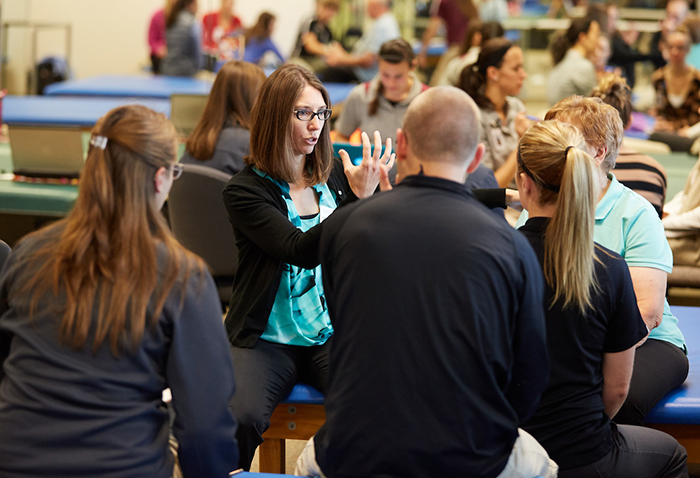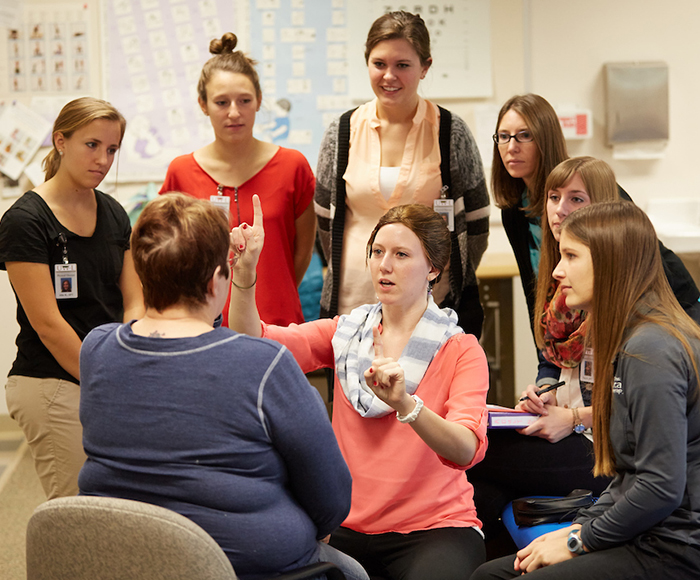Posted 11:45 a.m. Monday, Oct. 10, 2016

Faculty member joins Parkinson’s Disease Foundation pilot program to help train future physical therapy leaders.
Faculty member joins Parkinson’s Disease Foundation pilot program to help train future physical therapy leaders
Parkinson’s Disease affects about 1 million people in the U.S. — a number expected to double by 2030, according to the Parkinson’s Disease Foundation. While there is no cure for Parkinson’s, studies suggest that physical therapy and exercise can improve mobility and quality of life for those living with the disease. This means physical therapists play an important part in caring for people with Parkinson’s. The Parkinson’s Disease Foundation launched a “train the trainer” program to help teach the next generation of physical therapists who will work with Parkinson’s patients. Heather Fortuine, a UWL clinical assistant professor of physical therapy, was one of six faculty members across the U.S. selected to participate in the Physical Therapy Faculty Program at the Parkinson’s Disease Foundation in Boston in August. Faculty learned about the latest evidence-based findings in Parkinson’s research and care during the four-day program. [caption id="attachment_47006" align="alignright" width="700"] Heather Fortuine, UWL clinical assistant professor of physical therapy, instructs a group of doctor of physical therapy students who are performing a physical therapy initial evaluation on a person with Parkinson's Disease as part of the Applied Adult Neurological Rehabilitation course.[/caption]
“To keep up-to-date in my field is something I’m constantly working at,” says Fortuine. “It was a real gift to attend this program.”
Fortuine applied for the program because of the rich learning experience it would provide. She learned about current physical therapy related research and evidence-based interventions.
The program is applicable to Fortuine’s Adult Neuro Rehabilitation class she is teaching this fall to UWL’s Doctor of Physical Therapy program students. A week-long section of the course is devoted to Parkinson’s Disease. The training is also useful as she teaches a section of UWL’s Exercise Program for Adults with Neurological Disorders (EXPAND). In the program, physical therapy students work with members of the community who have neurological disorders. Supervised by a faculty member, students develop evidence-based exercise programs to improve participant’s health and well being. About 75 percent of EXPAND participants have Parkinson’s, notes Fortuine.
During the Physical Therapy Faculty Program, Fortuine observed neurosurgeons adjusting the settings on patients who had undergone deep-brain stimulation and observed first-hand the impact surgery had on their quality of life, motor symptoms and function. She also saw several different medical interventions for people with Parkinson's Disease such as botox injections, medication options, lifestyle changes and recommendations, and how the many different members of the medical team work together to provide holistic care for people with Parkinson's Disease.
[caption id="attachment_47008" align="alignright" width="700"]
Heather Fortuine, UWL clinical assistant professor of physical therapy, instructs a group of doctor of physical therapy students who are performing a physical therapy initial evaluation on a person with Parkinson's Disease as part of the Applied Adult Neurological Rehabilitation course.[/caption]
“To keep up-to-date in my field is something I’m constantly working at,” says Fortuine. “It was a real gift to attend this program.”
Fortuine applied for the program because of the rich learning experience it would provide. She learned about current physical therapy related research and evidence-based interventions.
The program is applicable to Fortuine’s Adult Neuro Rehabilitation class she is teaching this fall to UWL’s Doctor of Physical Therapy program students. A week-long section of the course is devoted to Parkinson’s Disease. The training is also useful as she teaches a section of UWL’s Exercise Program for Adults with Neurological Disorders (EXPAND). In the program, physical therapy students work with members of the community who have neurological disorders. Supervised by a faculty member, students develop evidence-based exercise programs to improve participant’s health and well being. About 75 percent of EXPAND participants have Parkinson’s, notes Fortuine.
During the Physical Therapy Faculty Program, Fortuine observed neurosurgeons adjusting the settings on patients who had undergone deep-brain stimulation and observed first-hand the impact surgery had on their quality of life, motor symptoms and function. She also saw several different medical interventions for people with Parkinson's Disease such as botox injections, medication options, lifestyle changes and recommendations, and how the many different members of the medical team work together to provide holistic care for people with Parkinson's Disease.
[caption id="attachment_47008" align="alignright" width="700"] Student Andrea Zahn performs a cranial nerve assessment as part of a physical therapy evaluation for a person with Parkinson's Disease. The practice was part of an Adult Neurological Rehabilitation course. Other doctor of physical therapy students in the picture include: Brenna Dubick, Tess Rademaker, Allie Knaus, Alisha Maciejewski and Erica Willadsen.[/caption]
Student Andrea Zahn performs a cranial nerve assessment as part of a physical therapy evaluation for a person with Parkinson's Disease. The practice was part of an Adult Neurological Rehabilitation course. Other doctor of physical therapy students in the picture include: Brenna Dubick, Tess Rademaker, Allie Knaus, Alisha Maciejewski and Erica Willadsen.[/caption]
